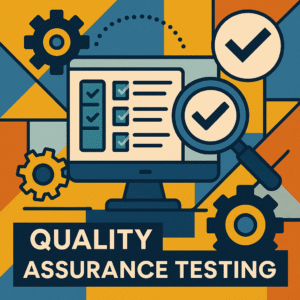5 Software Testing Strategies to Uplift Business Growth
The immense popularity of SaaS products in the market has been an important factor in the surge of start-ups delving into the software industry. However, when it comes to developing and putting a software product on the market, just a simple idea is not enough.
There are just as many failed software products in the market as similar offerings are abundant. This has cost companies a hefty amount in losses. As per a report by CISQ, the cost of poor quality software in the US alone amounted to a whopping $2.84 trillion.
Deteriorated quality can be due to numerous reasons. One of the major losses contributing to the cost was software failure, accounting for approximately 37% of this cost.
The tech start-up industry is a rapidly progressing one where the competition is quite cut-throat. In such a scenario, a great product is a start-ups survival kit.
Launching a product full of bugs leads to additional time in product marketing and cost while pushing the deadline to fix these bugs. These are the time and resources that an upcoming start-up just cannot afford.
The solution? Immaculate Software Testing.
Quality assurance through software testing helps the team detect potential defects in time to avoid additional loss.
Developing a detailed software testing plan compiled using effective strategies has quite a few benefits including saving up on time and resources while ensuring a quality end product.
Strategizing for software testing relies a lot on the method adopted for software development. Nowadays, most products are being developed using the microservices architecture, a variant of the SOA. In this scenario, one must adopt microservices testing strategies suited to their product.
3rd party services can you slow you down
Thanks to innovative technologies like API integrations, you can hook up the website with a service of your choice. For example, you may use a plugin that helps in customer analytics or a promotional banner.
Such services can cause your website to slow down or malfunction. It may not be apparent on your device but real users with different browsers and geographical locations can get affected. Ecommerce monitoring tool help you in detecting any issues with 3rd party services.
Here are a few software testing strategies that you can adopt to ensure the perfect end product:
1. Align your QA strategy to your business goals
- The growth of a business is determined through multiple achievements. Business owners must ask themselves this question; what is the purpose of software testing? How does the process affect the achievement of your business goals?
- A product is launched into the market with certain key achievements in mind. These goals must be communicated to the entire company including the QA and development team. This way, the developers will have a clear idea about the kind of product that you have in mind.
- While the QA team will strategize according to your requirements and test for perfecting the aspects that are crucial to your goals. This prevents a lot of post-launch debugging and troubleshooting.
- It also simplifies strategizing for the QA team who can then create a detailed plan focused on your goals, divide the tasks as needed and work with the development team for testing and debugging before the launch.
2. Create a detailed plan for testing and QA processes
- As mentioned before, the QA team must come up with a good strategy that aligns with the business goal. This strategy can be efficiently executed if the entire process of testing is well documented. Documentation is the key to maintaining consistency in quality. This plan can be divided into four segments:
- Quality management plan
A quality management plan is a documentation of testing the product for the desired level of quality that meets the customer requirements. It includes quality objectives, standards along with roles and responsibilities to assure the same.
- Testing strategy
This is a document prepared by a business analyst or project manager to align the testing process with the business requirements. It is focused on what the ideated product is and the aspects of the product that need to be tested thoroughly to meet the business goals.
- Test Plan
The team needs to draw out a detailed plan for testing in terms of what to test, how to test it and who will be conducting these tests.
- Test Case
A test case is the documentation of a set of conditions that need to be stimulated to verify certain functionalities of a particular feature.
- Quality management plan
- Each of these documents must contain the focus of the process, the key elements involved in the same. A standard policy to follow during the procedure along with the individuals involved in testing.
3. Suitable work environment for the QA team
- The work environment isn’t given much priority in terms of devising testing strategies. However, it is quite important as the overall work environment affects the attitude of the QA team. Here are a few steps you can take to ensure a healthy work environment for the team:
- Clear demarcation of tasks
- Involvement of the QA team in the development
- Expanding their knowledge base in terms of the business aspect of the product
- Open Communication
This will ensure a suitable work environment targeted towards efficient quality assurance.
4. Testing for User Acceptance
- A good product is developed keeping the end-user in mind. The QA team can understand the defined user persona for the product and test based on these user types.
- In such a scenario you can engage your end-users in the final stage of development and carry out user acceptance testing. Here’s how you can go about the same:
- Define a method for your UAT process
- Conduct testing in an organized manner
- Document the process
Many applications also include user onboarding before entering the app, briefing them about various functionalities and how to go about using their app. This makes it easier for the end-user to use your product.
5. Measuring Code Quality
-
Ensuring code quality is extremely important in software testing. Certain metrics help to make sure your code is running smoothly and is bug-free.
-
As per the CISQ Software quality model, here are a few metrics that you can use to measure code quality:
-
- Reliability Reliability defines how smoothly your code can run without failures. This includes the number of bugs found in production and the amount of time it takes to load the application.
- Performance Efficiency Performance efficiency can be defined by the quick responsiveness of the application to perform any given functionality. It can be defined through load testing or stress testing.
- Security Security can be measured by the application’s ability to detect any such issues and the time it takes to fix these errors.
- Maintainability Maintainability depends on the complexity of the code. It can be measured based on how many lines there are in the code and how simple or difficult it is to find a given line and modify the same.
- Rate of delivery The Rate of delivery is based on how quickly software is updated and delivered to the end-users.
-
These metrics can ensure that your code is up to the mark. Code being the backbone of your software, this is one of the most crucial testing strategies there is.
These are a few guidelines that you can follow to ensure a great quality end product that makes the best use of given resources.
It can get a little overwhelming, but breaking down these strategies into smaller tasks and delegating the same can help you in conducting a quick and efficient software testing process.
Author Bio:
Hardik Shah works as a Tech Consultant at Simform, a leading custom software development company, offering software testing services. He leads large scale mobility programs that cover platforms, solutions, governance, standardization, and best practices. Connect with him to discuss the best practices of software methodologies @hsshah_.
RECENT POSTS
Guides

How To Select a Regression Testing Automation Tool For Web Applications
Regression testing is an essential component in a web application development cycle. However, it’s often a time-consuming and tedious task in the QA process.

Switching from Manual to Automated QA Testing
Do you or your team currently test manually and trying to break into test automation? In this article, we outline how can small QA teams make transition from manual to codeless testing to full fledged automated testing.

Why you can’t ignore test planning in agile?
An agile development process seems too dynamic to have a test plan. Most organisations with agile, specially startups, don’t take the documented approach for testing. So, are they losing on something?

Challenges of testing Single Page Applications with Selenium
Single-page web applications are popular for their ability to improve the user experience. Except, test automation for Single-page apps can be difficult and time-consuming. We’ll discuss how you can have a steady quality control without burning time and effort.

Why is Codeless Test Automation better than Conventional Test Automation?
Testing is important for quality user experience. Being an integral part of Software Development Life Cycle (SDLC), it is necessary that testing has speed, efficiency and flexibility. But in agile development methodology, testing could be mechanical, routine and time-consuming.







Comments are closed.